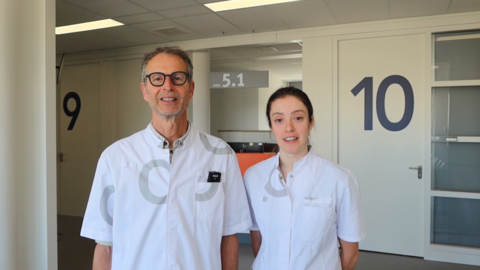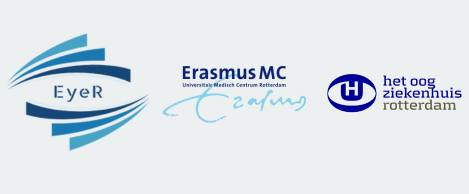CELDA: Improved Endothelial Cell Counting with AI

Overview
Traditional endothelial cell cameras often provide unreliable automatic cell counts, which can limit accurate diagnosis and research. Our innovative AI-powered tool CELDA offers significantly improved and reliable endothelial cell counting, surpassing the capabilities of standard camera software. CELDA was developed in-house by the Eye Image Analysis Group Rotterdam (EyeR), a joint effort of the Rotterdam Eye Hospital and the Erasmus MC. This program is designed specifically for research purposes and has not been validated for clinical use.

Key Research Applications
- Accurate Diagnosis and Follow-Up of Fuchs' Endothelial Dystrophy: The tool enables precise identification and quantification of endothelial cell changes associated with this condition.
- Valuable for Lens Surgery and Other Procedures: The tool provides insights into endothelial cell density both before and after lens surgeries or other ocular procedures.
- Reliable Monitoring After Corneal Transplantation: CELDA allows for accurate tracking of endothelial cell density following corneal transplants.
How CELDA Works
- Users can upload single or multiple corneal endothelium images in common formats, such as .jpg, .jpeg, .png, .tiff, .tif, and .bmp.
- The tool analyzes images and computes key endothelial biomarkers: Cell Count, Cell Density, Cell Size Variation, and Cell Hexagonality.
- A quality label can be assigned to each image, providing a user-generated metric for data consistency.
- All biomarkers and quality labels can be exported to Excel, allowing for further statistical analysis.
If you use this program in your research, please cite the following reference:
Vigueras-Guillén, J. P., van Rooij, J., van Dooren, B. T. H., Lemij, H. G., Islamaj, E., van Vliet, L. J., & Vermeer, K. A. (2022). DenseUNets with feedback non-local attention for the segmentation of specular microscopy images of the corneal endothelium with guttae. Scientific Reports, 12(1), 14035. https://doi.org/10.1038/s41598-022-18180-1
Contact
Would you like to download the program or do you have any questions about the program? Please send an e-mail to: celda@oogziekenhuis.nl.
CELDA: Verbeterde Endotheelceltelling met AI (NL)
Overzicht:
Traditionele endotheelcelcamera’s leveren vaak onbetrouwbare automatische celtellingen, wat een nauwkeurige diagnose en onderzoek kan beperken. Onze innovatieve, AI-gestuurde tool CELDA biedt een aanzienlijk verbeterde en betrouwbare endotheelceltelling, die de mogelijkheden van standaard camerasoftware overtreft. CELDA is intern ontwikkeld door de Eye Image Analysis Group Rotterdam (EyeR), een gezamenlijk initiatief van het Oogziekenhuis Rotterdam en het Erasmus MC. Dit programma is specifiek ontworpen voor onderzoeksdoeleinden en is niet gevalideerd voor klinisch gebruik.

Belangrijke Onderzoeksapplicaties (NL)
- Nauwkeurige diagnose en follow-up van Fuchs' Hoornvliesdystrofie: Deze tool maakt het mogelijk om veranderingen in endotheelcellen die verband houden met deze aandoening nauwkeurig te identificeren en te kwantificeren.
- Waardevol bij lensoperaties en andere ingrepen: De tool biedt inzicht in de endotheelceldichtheid zowel vóór als na lensoperaties of andere oogheelkundige ingrepen.
- Betrouwbare monitoring na hoornvliestransplantaties: CELDA maakt een nauwkeurige opvolging van de endotheelceldichtheid mogelijk na een hoornvliestransplantatie.
Hoe CELDA Werkt (NL)
- Gebruikers kunnen één of meerdere afbeeldingen van het corneale endotheel uploaden in veelgebruikte formaten, zoals .jpg, .jpeg, .png, .tiff, .tif, en .bmp.
- De tool analyseert de afbeeldingen en berekent belangrijke endotheel-biomarkers: Celaantal, Celdichtheid, Variatie in Celgrootte, en Celhexagonaliteit.
- Aan elke afbeelding kan een kwaliteitslabel worden toegekend, wat zorgt voor een door de gebruiker gegenereerde metriek voor dataconsistentie.
- Alle biomarkers en kwaliteitslabels kunnen worden geëxporteerd naar Excel voor verdere statistische analyse.
Als u dit programma gebruikt in uw onderzoek, vermeld dan de volgende referentie: Vigueras-Guillén, J. P., van Rooij, J., van Dooren, B. T. H., Lemij, H. G., Islamaj, E., van Vliet, L. J., & Vermeer, K. A. (2022). DenseUNets with feedback non-local attention for the segmentation of specular microscopy images of the corneal endothelium with guttae. Scientific Reports, 12(1), 14035. https://doi.org/10.1038/s41598-022-18180-1
Contact
Wilt u het programma downloaden of heeft u er vragen over? Stuur dan een e-mail naar: celda@oogziekenhuis.nl.